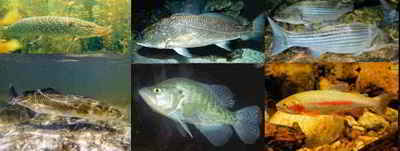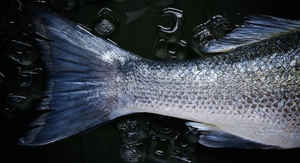
Vermont Symbols
Vermont State Warm-water Fish
Walleye Pike

(Stizosedion vitreum vitreum)
Adopted on May 3, 1978.
Vermont boasts the most unusual walleye, (Stizosedion vitreum vitreum,) designation. When students campaigned for the adoption
of the brook trout, the State Fish and Game Commission wanted to add the walleye because it inhabits Vermont's largest lake, Lake Champlain, which
is relatively warm. In a compromise, the brook trout was named the official cold water fish,
the walleye the state warm water fish on May 3, 1978.
Vermont State Warmwater Fish: Walleye Pike

Walleye (Sander vitreus, formerly Stizostedion vitreum) is a freshwater perciform fish native to most of Canada and to the Northern United States. It is a North American close relative of the European pikeperch. The walleye is sometimes called the yellow walleye to distinguish it from the blue walleye, which is a subspecies that can be found in the southern Ontario and Quebec regions.
Characteristics of the Walleye Pike
The walleye is the largest member of the perch family. It can grow to lengths of over 2 feet. The walleye's body shape is elongate, streamlined, and slightly compressed. The color of this fish is variable. It is generally brownish yellow to grayish yellow on the back and sides, shading to white on the belly. Young walleyes show vague saddle-shaped bands on the body. Walleyes differ from yellow perch in that they possess large canine-like jaw teeth.
Common Names:
Walleyed Pike, Pickerel, Jackfish, Dor
Identification
Walleye have a milky cast to their eyes. They have a long, round, olive body that has gold flecks on the sides with a white tip to the lower fork
of the tail. There is a distinct black blotch on the rear end of the first dorsal fin.
Walleye:
It was given this name because of the smoky, silvery eye, which is said to be similar to that of blinded or "walleyed" domestic animals
Stizostedion (steezo-stead?-eeon) means "pungent throat", according to the namer;
vitreum (vit?-tree-um) means "glassy", alluding to the nature of the large, silvery eyes
Typical Adult:
Length: Up to 30 inches
Weight: Up to 10 pounds
Life span: Up to 26 years
Habitat:
Walleye are most numerous in large, cool, windswept lakes with low to moderate clarity. They also live in large rivers. The preferred water temperature is 65-75 °F.
Feeding Behavior:
Walleye most prefer other fish, but also eat aquatic insects, leeches, crayfish, snails, and larval salamanders. They normally feed in dim light.
Reproductive Behavior (Spawning):
When: Walleye spawn in April and early-May
Preferred Water Temperature: Water temperatures in the shallows reach 4-7°C (40-45°F)
How: Walleye migrate from large lakes and rivers into small streams where they look for shallow gravel beds or areas of flooded vegetation. In lakes without good inlet streams, they move into shallow, rocky areas near shore. Walleye normally spawn during the night hours in about 0.3-1.5 m (1-5 ft) of water. Walleye are broadcast spawners, which means they swim above the spawning substrate (bottom material) and release their eggs and sperm into the water. Females release 200-300 eggs at a time, while one or more males fertilize them. This spawning act is repeated at roughly 5-minute intervals. A female may release all her eggs in a single night or may spawn over a period of several nights. Most males spawn for several nights. The fertilized eggs fall to the bottom, where they stick to the gravel or other bottom material. The parents give no care to the developing eggs (embryos actually) or the larvae that hatch from them. The embryos hatch in about 1-3 weeks, depending on the water temperature. In lakes, the larval walleye soon move into the deep, open water, where they develop into juveniles at about 25-30 mm. At this size they often return to the near shore areas of the lake, a movement pattern similar to the yellow perch
Adoption of the Vermont State Warm Water Fish
Joint Resolution R-91 of the Acts of 1978, effective on May 3, 1978, designated not one but two State Fishes: the Brook Trout (Salvelinus
fontinalis) as the cold water fish, and the Walleye Pike (Stizosedion vitreum vitreum) as the warm water fish. Both are handsome, sporty and tasty
game fish. The Brook Trout is the state's only trout native to its streams. Its mature weight varies considerably, depending on habitat in both cold
brooks and ponds, but generally averages under a pound. The biggest Brook Trout caught in Vermont since official records began in 1969 weighed 5 lbs.
12 oz. The Walleye Pike, found in many Vermont lakes, takes its name from its unusual "marble" eyes which in certain light look very light or transparent.
Its mature weight is four to eight pounds and the biggest one caught since 1969 weighed 12 lbs. 8 oz.
The walleye is the largest member of the perch family. It can grow to lengths of over 2 feet. The walleye's body shape is elongate, streamlined, and
slightly compressed. The color of this fish is variable. It is generally brownish yellow to grayish yellow on the back and sides, shading to white
on the belly. Young walleyes show vague saddle-shaped bands on the body. Walleyes differ from yellow perch in that they possess large canine-like jaw
teeth.
From Office of the Secretary of State, Vermont Legislative Directory and State Manual, Biennial Session, 1993-1994, p. 18.
Vermont Law
Because the walleye pike was adopted by Joint Resolution, it is not listed in the Vermont Statutes alongside other symbols such as the state bird, the state flower, and the state amphibian.
Taxonomic Hierarchy: Walleye
Kingdom: Animalia-- animals
Phylum: Chordata - chordates
Subphylum: Vertebrata - vertebrates
Class: Osteichthyes
Order: Perciformes
Family: Percidae
Genus: Stizostedion
Species: Stizostedion vitreum vitreum







